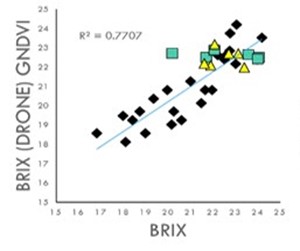Suitable vegetation indices for predicting sugarcane Brix content in the field
Main Article Content
Abstract
The goal of this research was to search for the optimal vegetation indices to predict the Brix content of sugarcane. The sugarcane of Khon Kaen 3 at age of 10 to 13 months was investigated. The models were optimized using regression equation by generating the relationship between four vegetation index (i.e NDVI GNDVI PVR and RVI) taken from multispectral image and measured °Brix content from ground sampling. The calibration model was developed using the sugarcane sample obtained from Sugarcane Breeding Institute, Khon Kaen university, while validation sets were the sugarcane sample from Bahn Phai Distric, Khon Kaen Province, and Saraburi province. The result showed that the overall °Brix content ranged between 16.8 and 24.8 oBrix. The vegetation index of GNDVI gave the best performance to be used as calibration model, providing the linear relationship of Y = -22.482x+31.832, where Y is predicted °Brix, x is GNDVI index. For the validation results, sugarcane in Bahn Phai Distric, Khon Kaen Province had the Bias value of 0.40 oBrix, and SEP value of 1.64 oBrix, meanwhile Saraburi province plant provided the Bias value of 2.80 oBrix, and SEP (standard error of prediction) value of 0.80 oBrix. The result indicated that multispectral imaging across the GNDVI index could be used as a real monitoring of cane quality in the field.
Article Details

This work is licensed under a Creative Commons Attribution-NonCommercial-NoDerivatives 4.0 International License.
References
Neamhom T, Polprasert C, Englande AJ Jr. Ways that sugarcane industry can help reduce carbon emissions in Thailand. Journal of Cleaner Production. 2016;131(10):561-71. https://doi.org/10.1016/j.jclepro.2016.04.142.
Yu D, Zha Y, Shi L, Jin X, Hu S, Yang Q, Huang K, Zeng W. Improvement of sugarcane yield estimation by assimilating UAV-derived plant height observations. European Journal of Agronomy. 2020;121:126159. https://doi.org/10.1016/j.eja.2020.126159.
Yano IH, Alves JR, Santiago WE, Mederos BJT. Identification of weeds in sugarcane fields through images taken by UAV and Random Forest classifier. IFAC-PapersOnLine. 2016;49(16):415-20. https://doi.org/10.1016/j.ifacol.2016.10.076.
Sofonia J, Shendryk Y, Phinn S, Roelfsema C, Kendoul F, Skocaj D. Monitoring sugarcane growth response to varying nitrogen application rates: A comparison of UAV SLAM LiDAR and photogrammetry. International Journal of Applied Earth Observation and Geoinformation. 2019;82:101878. https://doi.org/10.1016/j.jag.2019.05.011.
Ribeiro JB, da Silva RR, Dias JD, Escarpinati MC, Backes AR. Automated detection of sugarcane crop lines from UAV images using deep learning. Information Processing in Agriculture. 2024;11(3):385-96. https://doi.org/10.1016/j.inpa.2023.04.001.
Chea C, Saengprachatanarug K, Posom J, Saikaew K, Wongphati M, Taira E. Optimal models under multiple resource types for Brix content prediction in sugarcane fields using machine learning. Remote Sensing Applications: Society and Environment. 2022;26:100718. https://doi.org/10.1016/j.rsase.2022.100718.


